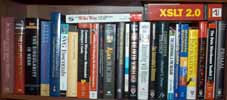|
|
Technology Strategy Books
I have a bookshelves full of 100s of books on IT strategy development.
Some of them good, some of them not so good. Looking back on the
e-business boom times that peaked in March of 2000 I recall that 15 of the 25
business best sellers were related to web and IT strategy development. Those
days are gone, and now you are lucky to see one or two books on any business
bestseller list. Through this all, I tried to pick out a few books that I
think have represented some of the best original thinking. Although some
of these books were actually written before the dot-com boom and bust, their
insights remain just as important today as when they were written.
Competitive Strategy –
Techniques for Analyzing Industries and Competitors
by Michael E. Porter
Any decent business strategist needs to be familiar with the works of Harvard's Michael
Porter. This book covers the core analytical techniques of a business
strategist. How do companies enter and exit markets? How do they
differentiate themselves in the marketplace? How do competitive goods effect a
companies strategy? If a person says they are a business strategist they
should at least have an opinion of Porter. They may not agree with everything
that Porter says, but they should at least have an opinion.The Discipline of Market Leaders -
Choose Your Customers, Narrow Your Focus, Dominate Your Market
by Michael Treacy and Fred Wiersema
Many companies need simple tools to help them focus their IT project
portfolio. I can think of few tools that helps more then this book.
According to this book, most people have three buckets they tend to put a
company in - low price (think Wal-Mart), product innovation (think Intel) or
customer intimacy (think Nordstrom). And their observations are that
companies that focus on one areas are much more profitable then companies that
try combinations. Once your management team picks one of these three
strategies we can build an IT plan that reinforces these strategies.
Net Ready - Strategies for Success in the E-conomy
by Amir Hartman, John Sifonis with John Kador
This book covers many of the core topics of building a robust IT
infrastructure. Companies that have a better technology foundation can
rapidly adapt to changing business requirements. It is one of the few books with
enough guts to get down to the details of ranking IT projects based on factors
such as business critically and practice innovation. It has a very useful
"Net Readiness Scorecard" scorecard that help you rate your companies ability to
adapt to changing requirements. Many of the firms I work with routinely
get scores of under 20 out of 100 possible points. It also puts the
spotlight on how a company must have technology literate leadership to make good
decisions about long term IT investments.
Crossing the Chasm -
Marketing and Selling Technology Products to Mainstream Customers
by Geoffrey A. Moore
1991, HarperBusiness
Most people who know me well know that I have two passions: Technology and
Marketing (with Leadership and Strategy close behind). This is one of the
first books that clearly explaind why how customers adopt any new technology
products. Geoffrey is the high priest of the Technology Adoption Life
Cycle: Innovators, Early Adopters, Early Majority, Late Majority and Laggards.
One of my first suggestions for many marketers in high technology companies is
"go read the bible according to Geoff." Geoff's later books - Inside the
Tornado and Living on the Fault Line are also worth reading if you
are interested in marketing aspects of technology.
The Balanced Scorecard - Translating Strategy into Action
by Robert S. Kaplan and David P. Norton
1996, Harvard Business School Press
Almost all of the firms I work with are generally happy with the technology
strategy documents I create and are impressed when I can clearly articulate complex IT concepts to
the board using metaphores they can relate to. I can also clearly point out
why this strategy is aligned with the business objectives of the firm.
But writing the strategy, explaining the strategy and creating IT projects is
only about 70% of the effort. The last 30% is putting processes in place
to make sure that the project stay on track and help the company meet their
objectives. Unfortunately many IT project don't all contribute directly to
the bottom line in a few quarters. This books is one of the best at
putting tools in place to measure long term benefits of IT projects.
Information Rules - A Strategic Guide to the Network Economy
by Carl Shapiro and Hal R. Varian
1999, Harvard Business School Press
There were literally 100s of books written about the "new economy".
Many of them tried to promote unrealistic business models based around
giving away web content and selling add banners. This is one if the few
books that applied basic theories of economics to information technology.
In fact it was written by two Economics professors from Harvard.
Every vendor and consumer of IT systems should read and re-read
the chapters on recognizing lock-in and managing lock in. Chapter seven on
networks and positive feedback form the basis of many of the external factor
analysis that is at the core of many highly successful e-Business strategies.
The One to One Future
Building Relationships One Customer at a Time
Don Peppers and Martha Rogers, Ph.D.
Here is the classic book on using technology to customize solutions for each and every customer.
Many companies don't use technology to find out who their best customers are.
Customer Relationship Management tools can now easily measure recency, frequency
and volume for every customer. This allows you to put a dollar amount or
"Lifetime Value" to every customer you touch. And of course this
information would be impossible to calculate if all your touch-points with the
customer are not integrated. But that would be another topic.
|







